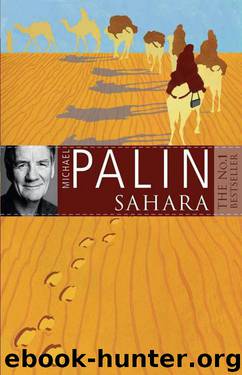Sahara (2002) by Michael Palin

Author:Michael Palin [Palin, Michael]
Language: eng
Format: epub, mobi
Tags: Michael Palin
ISBN: 9780753817391
Publisher: Orion Publishing Group
Published: 2002-05-26T23:00:00+00:00
Day Forty-Five
TlRELLI
The Sahara is officially said to begin north of latitude 16. The Pays de Dogon (it sounds so much better in French) is around 14 degrees north, but the cool night, which had me scrambling into my sleeping bag around 4 a.m., and the sand that has already found its way into the most private parts of me and my luggage, take me right back to our days in Western Sahara. As if the insidious sand isn’t enough, there is the added refinement of krim-krim, thorny burrs camouflaged in sand, which attach themselves to skin and clothing like fishhooks. Those of us who have already used the bushes as our bathroom have been particularly affected, and in quite sensitive places too.
There are bonuses of course, one of which is the spectacular sight of the escarpment wall, rising about a mile to the west of the camp, its long straight brow glowing red and gold in the early sunlight.
Little is known about the first people to inhabit the 125-mile escarpment other than that they were little and were called the Tellem. They fled to safety here 1000 years ago. They were planters and crop growers and no match for the Dogon hunters, originally believed to have come from the Nile Valley, who took over their land 400 years later, in their turn fleeing, this time from the spread of Islam.
The Tellem built houses in and amongst the caves halfway up the cliff wall, some of which can still be seen. The Dogon use them as burial grounds, often hauling bodies up on the end of ropes.
I learn all this from Amadou, an urbane English-speaking Dogon, who lives in Bandiagara. There is no shortage of esoteric information about the Dogon. In fact, there is a joke that runs ‘how many people are there in a Dogon family?’, the answer to which is five. Two parents, two children and one French anthropologist.
With Amadou as my guide, we drive over the ridge and down through scattered trees to Tirelli, one of a string of villages set at intervals into the base of the cliff. At first it’s hard to tell if there’s a village there at all. In the morning shadow its sandy-grey stone buildings merge with the rock in perfect camouflage. The effect is clearly intended.
The houses that rise steeply up the cliff-side are skilfully integrated with the massive boulders around them. They are built of dry-stone walls, capped with a smooth, chamfered layer of the clay, rice husks and straw mix known as banco. Water spouts project from the corners. Amongst the houses are the eye-catching granaries, with banco walls and pointed, overlapping mops of thatch, like witches’ hats. There are men’s and women’s granaries. The women’s are divided into four compartments: north, east, south and west. A representation of the world. Each one contains a different food: peanuts, millet, beans, rice. But in the middle of all these is a small circular hole, the centre of the world, and it
Download
This site does not store any files on its server. We only index and link to content provided by other sites. Please contact the content providers to delete copyright contents if any and email us, we'll remove relevant links or contents immediately.
1610396766 (N) by Jo Ann Jenkins(1300)
Whatever You Do, Don't Run by Peter Allison(1249)
Botswana--Culture Smart! by Michael Main(1240)
In Arabian Nights by Tahir Shah(1205)
The Old Farmer's Almanac 2020 by Old Farmer’s Almanac(1157)
Livingstone by Tim Jeal(1154)
Ubuntu by Ellis Heather;(1139)
The Templars by Michael Haag(1127)
Dead Eye by Mark Greaney(1112)
Africa: Altered States, Ordinary Miracles by Richard Dowden(1080)
Top 10 Israel and Petra by DK Travel(1073)
Morocco Travel Guide by Lonely Planet(1069)
Egypt Travel Guide by Lonely Planet(1059)
False Papers by André Aciman(1055)
The Promise of a Pencil: How an Ordinary Person Can Create Extraordinary Change by Braun Adam(1055)
First Comes Love, then Comes Malaria by Eve Brown-Waite(1042)
Jeff Corwin by Jeff Corwin(1032)
The Masked Rider by Neil Peart(991)
African Nights by Kuki Gallmann(969)
